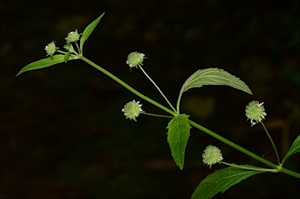- Worldwide distribution (except Africa). In Australia, Federated States of Micronesia, French Polynesia, Guam, Palau, Samoa, Solomon Islands.
- Forms dense thickets in open forests, forest margins and clearings, fallows, pastures, wastelands, roadsides, along streams. Replaces native species in open eucalypt forests and rainforests, and overgrazed pastures or those with poor nutrition. Produces abundant ‘seed’.
- Up to 2.5m, branching square stems, becoming woody. Leaves opposite, widely spaced, with serrated margins, and minty smell. Groups of flowers, white, in small clusters up to 25mm, in upper leaf axils. Individually, white, minute, round, surrounded by a tube of green leaf-like structures (calyx), turning brown and containing the fruit, which divides into four, forming the ‘seeds’. Ripe seedheads rattle.
- Spread: ‘seeds’ in water, attached to animals, clothing, in mud on vehicles, and in seed consignments.
- Biosecurity: check seed of pasture species.
- Biocontrol: none.
- Cultural control: hand-weed or slash infestations, making sure crown is removed to avoid resprouting; monitor and treat regrowth with herbicide. Apply fertilizer to promote rapid growth of pasture species. Clean machinery/vehicles.
- Chemical control: 2,4-D, glyphosate.







